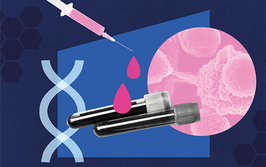
A Protein Probe for Progeria
Biomarkers could help track the progression of the syndrome and its treatments
Hutchinson-Gilford progeria syndrome (HGPS) is a rare genetic disorder characterized by phenotypic traits that mimic the appearance of rapid aging. The condition presents in early childhood and causes diseases such as atherosclerosis and stroke, often resulting in mortality by the time patients reach adolescence. Treatment options for HGPS are limited, but a recent study has identified novel protein biomarkers that may help monitor the syndrome’s progression and the effect of therapeutics (1). To learn more about the research and its implications, we spoke with Leslie Gordon, Professor of Pediatrics Research at Hasbro Children’s Hospital and the Alpert Medical School of Brown University, and Medical Director at The Progeria Research Foundation.
How did you identify relevant biomarkers?
For many years, we had been studying various hematologic tests to better characterize disease in children with HGPS. These tests were chosen based on clinical disease characteristics (for example, leptin due to lipodystrophy, lipid panel due to cardiac disease) and relevant questions about organ function. These were usually available as standard clinical tests and did tell us something about disease. However, we knew that there were hundreds of blood proteins that might or might not be obvious indicators of health and disease in HGPS. The development of technology that allows assessment of many proteins in a single test sample at low sample volume was immensely attractive because we cannot presume to know which proteins are causally tied to crucial disease characteristics, such as heart disease in children with HGPS. I was surprised at the pure number of proteins that were different from non-HGPS control children. Many of the proteins we have tested clinically are normal, so I really didn’t know what would happen in the multiplex assay.
Was the study particularly challenging, given the rarity of HGPS and its pediatric nature?
Because children with HGPS are so small, the amount of blood they can safely donate is very low. Because the prevalence is so rare (one in 20 million), the testing platform must be reliable because these blood samples are precious.
Once a child begins a trial treatment, there is no way to obtain an “untreated” sample again. Because a test for a single protein can require 100 or more microliters of plasma, we are always extremely conservative with the tests we perform. We chose a multiplex study because it allowed us to assess a large number of proteins using a small amount of plasma, while still being both sensitive and specific for any given protein.
Is enough research being done on rare diseases such as HGPS?
There can never be enough research; we need to race as fast as possible to a cure. And that means a lot of basic and clinical science – so we need as many researchers as possible to have the opportunity and the funding to test their brilliant new ideas and help these children. However, it’s always a challenge to obtain sufficient resources and interest to fund further research into rare diseases.
Although HGPS is one of the rarest diseases on earth, studies have confirmed a link between HGPS, heart disease, and the general aging process that affects us all. We all make a little bit of progerin, the toxic, disease-causing protein in HGPS. We make much less progerin than children with HGPS, but the protein builds up over a lifetime and may be partly responsible for aspects of normal aging, such as atherosclerosis.
Our study on biomarkers used samples obtained from The Progeria Research Foundation (PRF) Cell & Tissue Bank, along with samples from our PRF-funded clinical treatment trial at Boston Children’s Hospital. All of PRF’s programs collectively provide the resources needed not only to advance the field of HGPS, but also to discover what the condition can tell us about heart disease and aging (progeriaresearch.org).
- LB Gordon et al., “Survey of plasma proteins in children with progeria pre-therapy and on-therapy with lonafarnib”, Pediatr Res, [Epub ahead of print] (2018). PMID: 29342131.
My fascination with science, gaming, and writing led to my studying biology at university, while simultaneously working as an online games journalist. After university, I travelled across Europe, working on a novel and developing a game, before finding my way to Texere. As Associate Editor, I’m evolving my loves of science and writing, while continuing to pursue my passion for gaming and creative writing in a personal capacity.




















